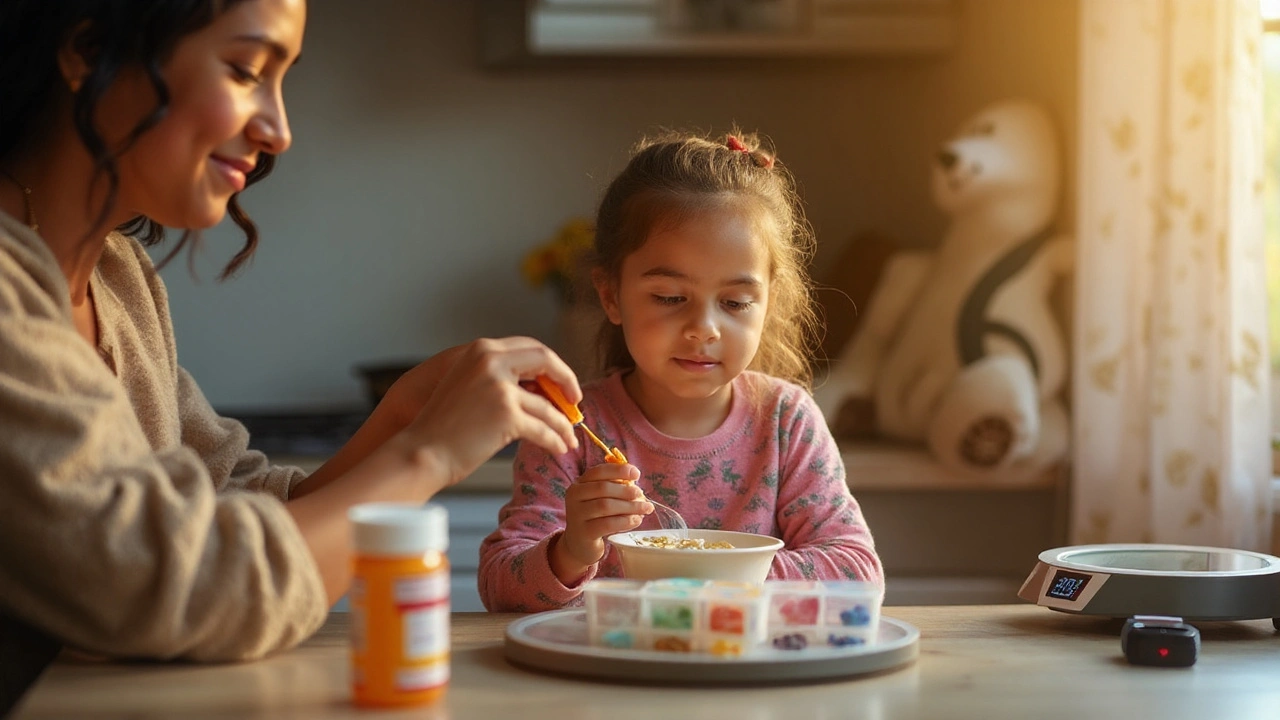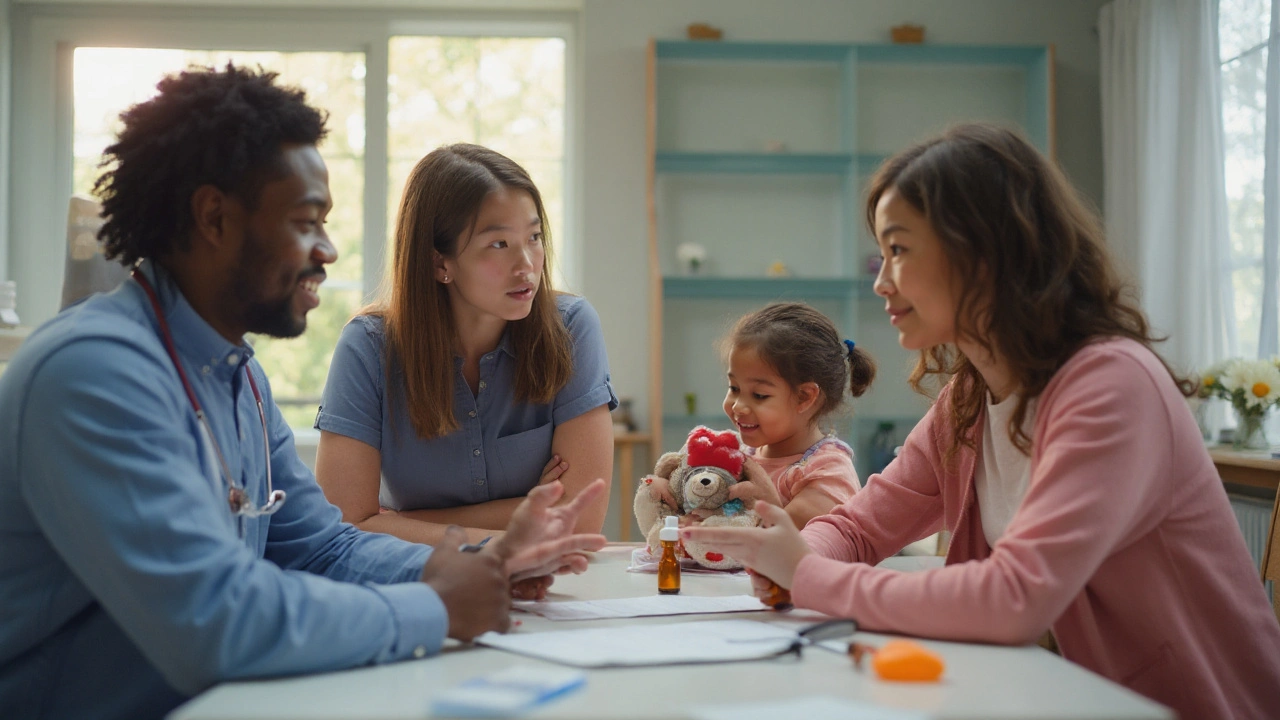Parents hear the word “heart failure” and want the fastest, safest fix. Digoxin has been around forever, but does it still help kids? Short answer: yes, in the right child and the right situation. It can ease symptoms and, in a few specific congenital heart set‑ups, may improve survival between surgeries. It’s not a cure, and it’s not first-line for most children anymore, but it still earns its spot.
TL;DR: Does digoxin still have a role in pediatric heart failure?
- It can improve symptoms (feeding, breathing, exercise tolerance) in some children with heart failure due to congenital heart disease or ventricular dysfunction, especially when standard meds aren’t enough.
- It’s most clearly helpful in babies with single-ventricle physiology between staged surgeries-several multicenter studies found lower interstage mortality when digoxin is used.
- It’s not a first-choice drug for most pediatric heart failure. Diuretics, ACE inhibitors/ARNI, and beta‑blockers are the backbone. Digoxin is often an add‑on.
- Safety depends on tight dosing, kidney function, electrolytes, and drug interactions. Regular blood levels and ECGs are part of the plan.
- If your child vomits repeatedly, seems unusually sleepy, has slow heart rates, or new rhythm issues, call the care team fast. Those can be warning signs of toxicity.
When (and why) doctors choose digoxin in children
Digoxin isn’t new. It boosts the heart’s squeeze (positive inotropy) and calms the body’s stress signals (vagotonic effect). That two‑for‑one action can relieve symptoms in children with a weak pump or certain congenital heart defects. The flip side: the therapeutic window is narrow, so clinicians use it selectively.
Where it helps most:
- Interstage single-ventricle infants (for example, after the first surgery in hypoplastic left heart syndrome). Multiple registry and network studies have reported fewer deaths between surgeries in babies on digoxin. This signal has been consistent enough that many centers include digoxin in their interstage protocols.
- Symptomatic infants with significant left‑to‑right shunts (like a large VSD) struggling with feeding and weight gain despite diuretics. Digoxin can reduce sympathetic drive and sometimes improve feeding endurance while the team plans definitive repair.
- Children with dilated cardiomyopathy and reduced ejection fraction, already on diuretics and neurohormonal blockers, who still have symptoms. Evidence in pediatrics is limited, but some clinicians use digoxin to improve quality of life and reduce hospitalizations.
Where it’s usually not first choice:
- Primary right heart failure from lung disease or pulmonary hypertension-digoxin doesn’t address the main driver.
- Acute myocarditis with unstable rhythms-risk can outweigh benefit unless a specialist directs it.
- Children with normal pump function but failure symptoms from other causes (for example, severe anemia or thyroid issues). Fixing the cause works better.
What the evidence actually says (no sugar‑coating):
- Randomized trials in children are sparse and old. Contemporary pediatric practice leans on physiology and adult heart failure data, plus observational pediatric studies.
- An American Heart Association scientific statement on pediatric heart failure highlights digoxin as an add‑on option with limited high‑grade pediatric evidence but practical utility in select cases.
- Pediatric Heart Network and other multicenter datasets (interstage single‑ventricle) suggest lower mortality with digoxin, even after adjusting for how sick babies were. While not randomized, the consistency across large cohorts matters.
How it works in simple terms: it helps the heart squeeze a bit harder and tamps down excess adrenaline‑type signals. That can translate into better feeding stamina in infants, less breathlessness, and fewer flare‑ups. Just don’t expect it to reverse a structural problem-that’s what surgery or catheter procedures are for.
If you’re in Australia: digoxin is widely available as an oral liquid and tablets, and dosing is calculated by weight and kidney function. Most pediatric cardiology units in Australia and New Zealand follow similar selection criteria and monitoring schedules to US/European centers.

Safety first: monitoring, interactions, red flags
With digoxin, precision keeps kids safe. The difference between “helpful” and “too much” can be small, especially in babies. Here’s how teams manage that risk.
Monitoring essentials:
- Baseline: kidney function (creatinine), electrolytes (potassium, magnesium, calcium), and an ECG. These set the starting line.
- Blood levels: the first check is usually done after steady state (about 5-7 days), then periodically. Levels should be drawn at least 6-8 hours after the last dose to reflect a true tissue level, not the recent peak.
- Target range: for heart failure, many teams aim on the lower side (around 0.5-0.9 ng/mL) to reduce toxicity risk while maintaining benefit. Higher targets may be used for certain rhythm problems, but that’s a different indication.
- ECG and rhythm checks: especially at the start, after dose changes, or if symptoms pop up.
- Electrolytes: any drop in potassium or magnesium makes toxicity more likely. Diuretics can lower both, so labs matter.
Common interactions that raise digoxin levels:
- Amiodarone and dronedarone
- Verapamil and diltiazem
- Macrolide antibiotics (like clarithromycin) and some antifungals (like itraconazole)
- Certain antivirals and immunosuppressants (for example, ritonavir‑boosted regimens or cyclosporine)
Interactions that lower levels or reduce absorption:
- Some antacids and high‑fiber supplements
- St John’s wort
Red flags parents actually see at home:
- Repeated vomiting not explained by a bug
- Unusual sleepiness, confusion, or poor feeding
- New slow heart rate (if you use a home monitor) or episodes of paleness/blue lips
- Older kids: dizziness, seeing halos/yellow tinge, or palpitations
If any of those show up, don’t wait for the next clinic visit-call the team or go to urgent care. Digoxin toxicity is treatable, but only if you catch it early.
Special populations:
- Preterm infants and neonates: kidneys clear digoxin slowly; dosing is lower and level checks are more frequent.
- Children with kidney impairment: the drug sticks around longer; dosing adjustments and close labs are mandatory.
- Dehydration (hot days, gastro): less blood volume means higher levels; keep up fluids and call your clinician if vomiting or diarrhea lasts more than a day.
What about long‑term harms? The main concern is cumulative exposure leading to arrhythmias when something shifts (like a new medicine or a stomach bug). Regular labs and honest reporting of new meds keep the odds low. There’s no evidence digoxin stunts growth or cognitive development at therapeutic levels.
Daily life with digoxin: step-by-step playbook for families
Here’s the practical “how we do it” that pediatric cardiology teams in places like Sydney follow.
- Confirm the goal. Is the aim to improve feeding and breathing, bridge to surgery, or support a weak ventricle? Knowing the “why” helps you watch for the right wins.
- Get the right formulation. Most infants use liquid digoxin measured with an oral syringe, not a kitchen spoon. Ask your pharmacist to label the syringe with the exact mL for your child’s dose.
- Set a dosing routine. Same times daily, 12 hours apart for twice‑daily regimens. Consistency reduces peaks and troughs. If your child spits up within 10 minutes, call your team before repeating a dose.
- Plan the first level check. Expect a blood test 5-7 days after starting or changing dose. Time it at least 6-8 hours after the last dose. Put it in your calendar; steady state matters.
- Coordinate meds. Tell the team about every new prescription, over‑the‑counter drug, and supplement. If an antibiotic is needed (say, for an ear infection), the cardiology team may temporarily adjust digoxin or ask for an extra level.
- Watch hydration and electrolytes. On hot summer days or with a tummy bug, offer small, frequent fluids. If your child is on a diuretic, ask whether an electrolyte supplement is part of the plan.
- Track signals, not just symptoms. For babies, weigh at home 2-3 times a week. For older kids, note exercise tolerance and school day fatigue. Share trends, not just snapshots, at clinic visits.
- Have a missed‑dose plan. If you remember within 4 hours, give it. If it’s close to the next dose, skip and resume the regular schedule. Never double up unless your clinician tells you to.
- Know your red flags. Repeated vomiting, dramatic sleepiness, or new rhythm alerts on home monitors deserve a call-today, not tomorrow.
- Keep follow‑ups tight. Early in therapy, visits and labs are closer together. As things stabilize, the schedule stretches out. If anything big changes (growth spurts, new meds), the clock resets.
Results you should reasonably expect:
- Infants: better feeding stamina within 1-2 weeks and more settled breathing if heart failure was the limiting factor.
- Older children: less breathlessness with play and fewer “bad days” after a few weeks.
- Single‑ventricle interstage: not a visible day‑to‑day change you can rely on; the benefit is risk reduction between surgeries.
What you won’t get from digoxin: a fix for a hole, a valve problem, or a tight vessel. Think of it as a supportive teammate, not the star striker.

Quick tools: decision aids, tables, and a parent checklist + Mini‑FAQ
Use these tools to make decisions and stay organized.
| Clinical scenario | Expected benefit | Evidence quality | Notes |
|---|---|---|---|
| Interstage single‑ventricle infants | Lower mortality between surgeries | Moderate (large observational cohorts) | Often part of protocol; monitor closely |
| Infants with large shunt (e.g., VSD) and symptoms | Better feeding, less tachypnea | Low‑to‑moderate (older trials + practice) | Bridge to repair; diuretics remain core |
| Dilated cardiomyopathy with reduced EF | Symptom relief; possible fewer admissions | Low (extrapolated + small pediatric data) | Use after modern heart failure meds |
| Heart failure with preserved EF or non‑cardiac causes | Minimal | Low | Address underlying cause first |
Parent checklist (print this):
- Do I know exactly why my child is on digoxin?
- Do I have the correct oral syringe and can I show someone how I measure the dose?
- When is the first (or next) blood level due? Is it 6-8 hours after a dose?
- What’s our missed‑dose plan?
- Which meds and supplements should we avoid or report?
- What are my child’s personal red flags?
- Who do I call after hours if I’m worried?
Rules of thumb that keep kids safe:
- Consistency wins: same dose times, same measuring tool.
- Hydration prevents surprises: dehydration concentrates digoxin.
- Any new med? Ask first. A five‑minute call beats a hospital visit.
- Labs tell the story: schedule them before you leave clinic.
Mini‑FAQ
- Is digoxin still used if my child’s main issue is a fast rhythm (SVT)? Yes, but that’s a different indication. For SVT, digoxin is one of several options; treatment plans differ from heart failure plans.
- Can my child stop digoxin suddenly? Not without a plan. Stopping abruptly can worsen symptoms. Teams usually taper or switch based on labs and clinical status.
- What if my child throws up after a dose? If it’s within 10 minutes, call your team for advice before repeating. Repeated vomiting can also be a toxicity sign.
- Does food matter? Food can slightly reduce absorption. Most teams prefer steady habits: either always with food or always without to keep levels predictable.
- Is breastfeeding safe while on digoxin? Yes. Only tiny amounts pass into milk, and it’s generally considered compatible.
- Will vaccines or common colds affect digoxin? Vaccines don’t interfere. Fevers and tummy bugs can affect hydration and electrolytes; if illness lasts, call the team.
- What level is “toxic”? There’s no single number. Many clinicians aim for 0.5-0.9 ng/mL in heart failure. Symptoms, ECG, electrolytes, and the whole picture matter more than a lone level.
How clinicians decide, step by step, in 2025:
- Confirm heart failure type and anatomy; fix what’s fixable.
- Start proven foundation meds (diuretics; ACE inhibitor or ARNI; beta‑blocker if appropriate).
- Add digoxin for heart failure if symptoms persist or in specific congenital heart settings (like interstage single‑ventricle), and build a monitoring plan.
- Review all meds for interactions, set level targets, and book follow‑ups before discharge.
What I’ve seen families value most is clarity: what to watch, when to test, who to call. When those pieces are in place, digoxin can be a steady, quiet helper while the bigger plan-growth, surgery, rehab-does its work.
Sources to anchor your decisions: an AHA scientific statement on pediatric heart failure (2019) outlines where digoxin fits; multicenter pediatric heart networks have consistently shown lower interstage mortality with digoxin in single‑ventricle infants; adult heart failure trials support low‑range digoxin levels for symptom relief, often extrapolated in pediatrics. Your child’s cardiology team blends these data with your child’s anatomy, age, and kidneys. That’s the art and science.


Brittany McGuigan
August 30, 2025 AT 00:53The role of digoxin in pediatric cardiology remains a nuanced topic deserving rigorous scrutiny. While some clinicians cling to antiquated dogma, contemporary data suggest selectve benefit. Infants with single‑ventricle physiology, particularly in the interstage period, have demonstrated lower mortality when carefully monitored on digoxin. This observation is supported by multiple cohort analyses across North America and Europe. Nonetheless, the drug’s narrow therapeutic index mandates vigilant dosing and laboratory surveillance. Renal function, electrolyte balance, and concomitant medications such as amiodarone profoundly influence serum levels. In practice, a target trough of 0.5‑0.9 ng/mL often balances efficacy with safety. Parents must be educated about the signs of toxicity, including persistent vomiting and excessive somnolence. Moreover, interdisciplinary teams should coordinate lab timing to cature true steady‑state concentrations. It is also imperative to recognize that digoxin does not replace definitive surgical repair. Rather, it serves as an adjunct, buying tiime and improving quality of life until curative interventions can be performed. For children with dilated cardiomyopathy unresponsive to standard neurohormonal blockade, digoxin may modestly reduce hospital readmissions. However, the evidence base is limited, and clinicians must weigh individual patient factors. The decision algorithm therefore integrates anatomy, hemodynamics, renal clearance, and caregiver capacity. In institutions with robust interstage protocols, digoxin has become a standard component of care. Ultimately, the judicious use of digoxin, anchored by meticulous monitoring, continues to hold relevance in contemporary pediatric heart failure management.
Priya Vadivel
September 7, 2025 AT 01:06I completely understand how overwhelming this information can feel, especially when you are juggling daily care, appointments, and the endless list of medications, so let me break down the key monitoring points in a friendly way, starting with baseline labs, then moving to timing of serum levels, and finally the importance of electrolyte balance, all of which are crucial to keep digoxin safe and effective.
Dharmraj Kevat
September 15, 2025 AT 03:33We watch the heart race we pray the levels stay low the stakes are high the kids deserve a chance digoxin is a double‑edged sword hope battles fear every day.
Lindy Fujimoto
September 23, 2025 AT 06:00Wow, the dedication of families is truly awe‑inspiring 🌟, and seeing digoxin help those tiny fighters feels like a miracle in disguise 😊! Remember, every dose is a step toward stability, so keep those labs on schedule, stay hydrated, and never hesitate to call the team if anything feels off 🚨💉.
darren coen
October 1, 2025 AT 08:26It’s reassuring to see how a structured plan can ease worries and improve outcomes.
Jennifer Boyd
October 9, 2025 AT 10:53Hey there, you’re doing an amazing job navigating this complex therapy! 🎉 Keep celebrating the small victories – like a weight gain or a calmer night – because they add up to big wins. If you ever feel stuck, remember that the care team is just a call away, ready to adjust doses or answer questions. Together, we’ll turn those challenging moments into stories of resilience. Stay hopeful and keep that spirit shining bright! 🌈
Lauren DiSabato
October 15, 2025 AT 05:46Honestly, many parents overreact to minor side‑effects.